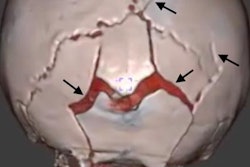
U.S. emergency departments continue to rely on CT to routinely evaluate children presenting with head trauma, despite long-standing efforts -- such as the Image Gently initiative -- to reduce overuse of the exam, according to an article published online September 4 in Pediatrics.
Researchers from the U.S. and Canada, led by first author Dr. Brett Burstein from McGill University Health Centre in Montreal, analyzed information from the U.S. Centers for Disease Control and Prevention's (CDC) National Hospital Ambulatory Medical Care Survey database to determine the usage rate of CT for pediatric head trauma. They were particularly interested in tracking CT use in light of concerns over the high rate of unnecessary CT exams performed on children with head trauma.
Multiple studies have affirmed that the majority of head injuries in children do not result in clinically important traumatic brain injury (TBI), suggesting that physicians can safely avoid the excessive use of CT for these patients, the authors noted. Yet Blackwell et al reported that CT neuroimaging for pediatric head trauma increased nearly twofold from 1995 to 2003.
In response to this and similar findings, the Image Gently Alliance spearheaded a campaign starting in 2008 to reduce the overuse of CT for children, thus minimizing their exposure to radiation and lowering healthcare costs. This eventually led to the development of the Pediatric Emergency Care Applied Research Network (PECARN) clinical prediction rules in 2009 for the emergency assessment of children with head injuries.
Since then, multiple trials have demonstrated that the PECARN rules are capable of decreasing the rate of unnecessary CT exams for pediatric head trauma without missing injuries that require surgical intervention. Accordingly, Burstein and colleagues hypothesized that there would be a marked decline in CT use for children following the release of the PECARN rules.
Their analysis, however, revealed that there was no statistically significant change to CT use among children with head injuries from 2007 to 2015. Among 3,054 emergency cases, an average 32% of children underwent a head CT exam each year, with no significant linear trend after adjusting for age, sex, and race, among other variables.
In contrast to the authors' initial supposition, there was no statistically significant difference between the proportion of patients who underwent CT before and after publication of the PECARN rules.
| CT usage rate for pediatric head trauma before vs. after PECARN publication | ||
| Before PECARN (2007-2009) | After PECARN (2010-2015) | |
| Percentage of patients who underwent CT | 33.2% | 31.4% |
Furthermore, they found an association between the use of head CT in children and several patient factors, including age of at least 2 years, white race, a triage acuity of "urgent" or higher, and presentation at a nonteaching or nonpediatric hospital.
"Results from this large nationally representative study suggest a need for targeted quality improvement initiatives to ensure appropriate CT use in this patient population," they wrote.




















